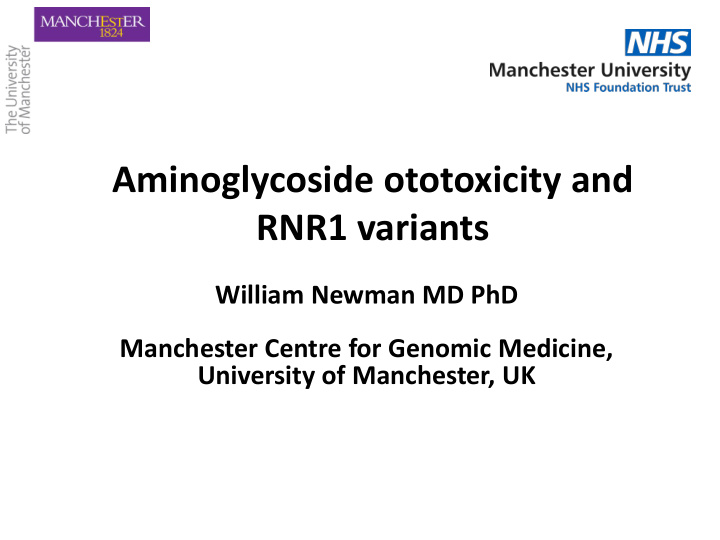



Aminoglycoside ototoxicity and RNR1 variants William Newman MD PhD Manchester Centre for Genomic Medicine, University of Manchester, UK
Disclaimer • I have just been awarded a grant from the NIHR in the UK to assess the feasibility of a point of care test in neonatal units to avoid gentamicin ototoxicity • Working with a commercial company genedrive plc who produce the POCT • I have no financial relationship with genedrive or other COI
Background • Gentamicin is an aminoglycoside antibiotic that is active against gram-negative bacteria. • Administered by iv, im or topically • treatment of neonatal septicemia, especially in premature babies, cystic fibrosis, surgical prophylaxis, neutropenic sepsis • single injection of gentamicin may cause hearing loss in individuals who have a m.1555A>G variant in MT-RNR1 .
Evidence for association • Prezant et al in 1993 described 3 Chinese families with maternally inherited aminoglycoside ototoxicity • The m.1555A>G conserved variant segregated with the phenotype in these families • Subsequent reports of the association between this variant and gentamicin induced ototoxicity
Effects of gentamicin in susceptible individuals • Hearing loss is bilateral, usually severe to profound, and irreversible. • Occurs in genetically susceptible individuals even in cases where drug levels remain within the therapeutic range. • Contrast with dose-related ototoxicity – occurs over days • Nephrotoxicity – usually reversible, dose-related, not associated with mitochondrial variant
Relevant to more than gentamicin • Six aminoglycoside drugs currently approved for use by the FDA: amikacin gentamicin neomycin paromomycin streptomycin tobramycin
Mechanism of action • Aminoglycosides bind to 30S bacterial ribosomal subunit to disrupt translation • Sequence variants in the ribosomal decoding region make mitochondrial RNA more similar to bacterial rRNA, thereby facilitating the binding of aminoglycosides. • Hair cells in the cochlea are susceptible and irreplaceable
Genetic details Relationship between variant and ototoxicity • m.1555A>G variant is nearly always homoplasmic • Reported complete penetrance when exposed to aminoglycosides • Results in late onset (>40 years) SNHL in individuals not exposed to aminoglycosides
Allele Frequencies • In the UK (in 500,000 controls UK Biobank) frequency 0.2% (1 in 500) • 0.18% in 58,397 Chinese neonates • Varying frequencies reported in hearing impaired populations
Clinical Presentation • Potentially neonates are more susceptible • Other environmental modifiers - noise • Does not affect vestibular system Treatment – bilateral hearing aids/ cochlear implantation
Avoidance of ototoxicity • Opportunistic testing of individuals prior to gentamicin treatment (cystic fibrosis/bronchiectasis patients, presurgical) • Neonatal Screening (would not capture preterm babies) • Pregnant mothers (as all offspring would carry the variant) • Point of care testing
Advice • WHO “pre -treatment screening is an important consideration to prevent aminoglycoside related hearing loss but given cost and access issues, asking about a maternal family history of deafness may be more practical” • American College of Medical Genetics and Genomics (ACMG) testing for mitochondrial DNA mutations associated with aminoglycoside ototoxicity may be considered for individuals with a history of use of aminoglycoside antibiotics • FDA-approved drug label for gentamicin does not include a statement about m.1555A>G.
Many Unknowns • Relevance of other variants in RNR1 e.g. m.1494C>T, m.961_962deltinsC(n) • Evidence level – no RCT (no clinical equipoise) • No historical retrospective studies • Penetrance – incomplete? • Population allele frequencies • Relevance across different age groups • Relevance across different aminoglycosides
References • Prezant TR, et al. 1993. Mitochondrial ribosomal-RNA mutation associated with both antibiotic-induced and non-syndromic deafness. Nat Genet. 1993; 4(3): 289-94. • Dean L. Gentamicin therapy and MT-RNR1 genotype. Medical Genetics Seminars 2012. • Pandya A. Non syndromic hearing loss and deafness, mitochondrial. GeneReviews 2014.
Recommend
More recommend